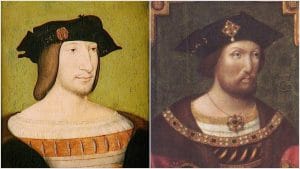
Chronicler Edward Hall records:
“The Ambassadours beyng dayly in counsail at Grenewiche, the other gentlemen daunced & passed the tyme in the quenes chambre with ladies & gentlewomen. After long cousailing & muche desyring of the French kyng and his counsayll, it was agreed that the citie of Tourney should be deliuered to the Frenche kynge, he payenge vi. hundred thousande crounes for the citie, and iiii. hundred thousand crounes for the Castell, the which the kyng had buylded, but it was not fully performed: & also he should pay xxiii. M. l. Tourneys, the whiche summe the citezens of the citie of Turney ought to the kyng of England for their liberties and fraunchises.
Vpon these agremetes to be performed, it was concluded that the citye of Tourney should be delivered to the French kyng. The Frenchmen the soner to come to their purpose, made a pretence of mariage to be had between the Dolphyn, sonne & heyre to the Frenche kyng & the lady Mary the kynges daughter, which was agreed vpon this condicion, that if they both consented at lawfull age, then to be ferme & stable, or els not for they were both very young.”
Admiral Bonnivet, standing in for the infant Dauphin, was betrothed to little Mary in a ceremony in Queen Catherine of Aragon’s chamber at Greenwich Palace on 5th October 1518:
“Notarial attestation by Robert Toneys and John Barett that, on 5 Oct. 1518, in the Queen’s Great Chamber at Greenwich, after an oration de laudibus matrimonii by Dr. Tunstal, Lord Bonivet took the hand of the Princess Mary, and espoused her in the name of the Dauphin of France; and the King and Queen espoused the Dauphin, in the person of Lord Bonivet, to the Princess. Bonivet then put a ring on the fourth finger of her right hand, the Cardinal of York assisting: after which the King and Bonivet signed the forms of their oaths. Then the King proceeded from the chamber, and went to his chapel in the manor of Greenwich, where, at the high altar, the King took his oath to the treaty of 4 October last, and the French ambassadors swore that Francis should observe the same.”
As Edward Hall points out, it was decided that the betrothal would only be binding of the couple consented to it when they were older. The betrothal was broken off in 1521 when Mary was instead contracted to marry her cousin, Charles V, Holy Roman Emperor.
Notes and Sources
- Hall, Edward (1809) Hall’s chronicle: containing the history of England, during the reign of Henry the Fourth, and the succeeding monarchs, to the end of the reign of Henry the Eighth, in which are particularly described the manners and customs of those periods. Carefully collated with the editions of 1548 and 1550, J. Johnson, p. 594.
- Letters and Papers, Foreign and Domestic, Henry VIII, Volume 2, 1515-1518, 4480.
- “Mary’s suitors – Part I: The Dauphin, François” by Nasim Tadghighi – http://mary-tudor.blogspot.com.es/2010/09/marys-suitors-part-i-dauphin-francois.html